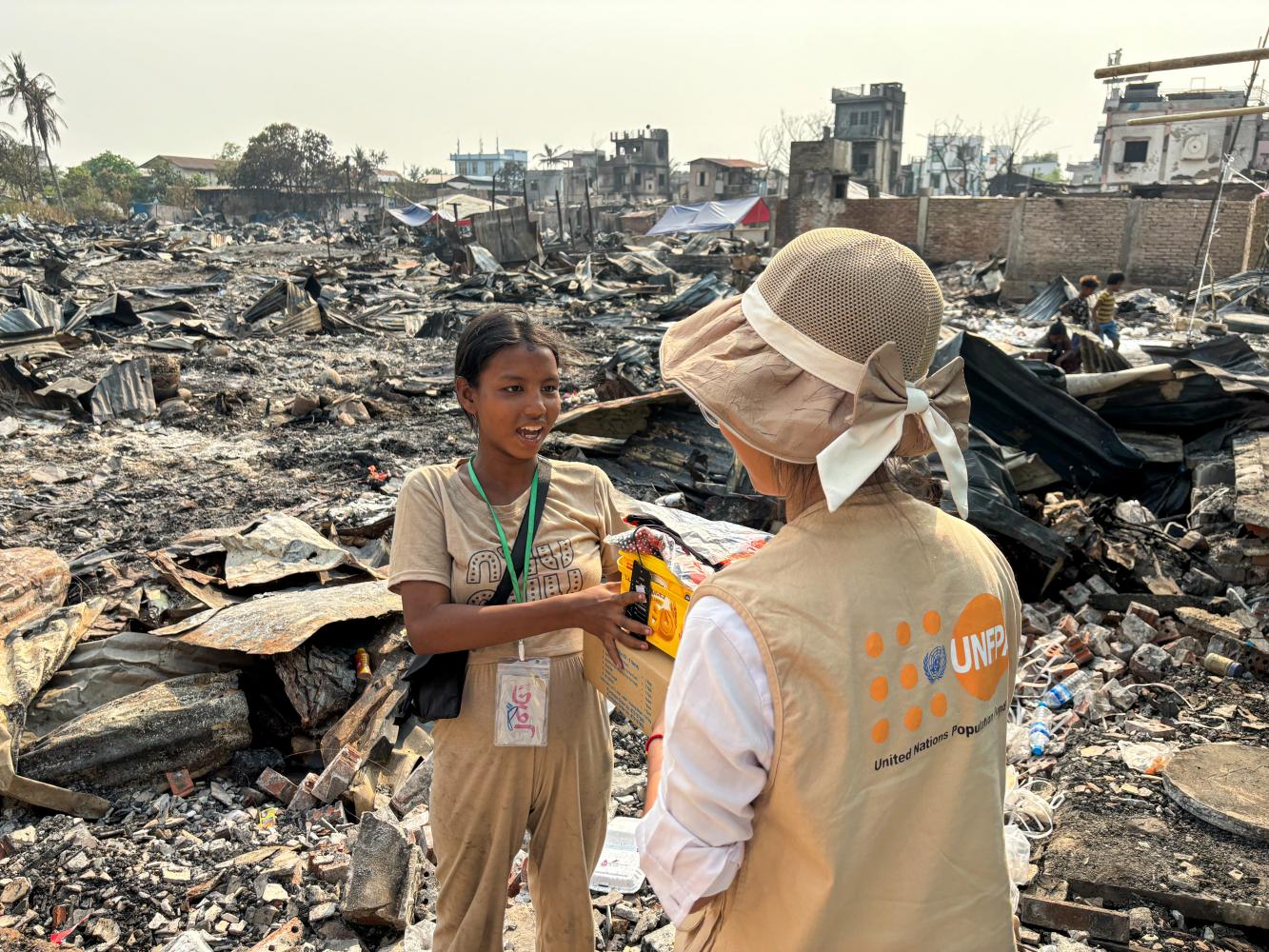A network of health workers, midwives, and community responders stands at the frontline when disaster strikes, often arriving first and staying longest to save lives. From flood-ravaged villages in Nepal to conflict-torn areas in Myanmar, these dedicated professionals operate under duress—navigating violence, scarce resources, and dangerous conditions to deliver essential care. Their work spans conflict zones, climate-induced disaster zones, and displacement camps, highlighting a critical truth: women and girls bear the heaviest burden when health services falter in emergencies.
In Myanmar, the scale of displacement multiplies the urgency of humanitarian action. Millions of women and girls have been uprooted, both within the country and into neighboring regions, creating a vast humanitarian footprint that demands sustained, locally led health responses. The Rohingya crisis, eight years on, remains a stark reminder of how displacement reshapes health landscapes. The mass exodus to Cox’s Bazar, Bangladesh—the world’s largest refugee settlement—continues to strain resources and test the capacity of aid organizations to protect the rights and dignity of displaced populations. Against this backdrop, humanitarian actors strive to ensure maternal health, reproductive services, and protection converge to safeguard vulnerable communities, even as new emergencies emerge.
Six months after large-scale funding reductions to UNFPA—the United Nations Population Fund for Sexual and Reproductive Health—there is a measurable—and concerning—response in the field. The sustained impact on the lives of the people who rely on these services is evident: maternal health clinics have closed, mobile health teams have been suspended, and the delivery of critical reproductive health supplies has been delayed. In effect, millions are left without access to essential services that can be the difference between life and death for mothers, newborns, and families. This funding gap translates into concrete, harmful outcomes: preventable complications in pregnancy, delays in emergency obstetric care, and the erosion of a safety net designed to protect women and girls during the most vulnerable moments of their lives. The ripple effects extend beyond individual health, touching families, communities, and the stability of entire regions grappling with ongoing crises.
At the same time, attacks on healthcare are increasing, presenting a grave global challenge to humanitarian efforts. The past year marked the deadliest period on record for aid workers, with national staff bearing the brunt of risk in many crisis zones. Across the world, more than 1,600 attacks on health care workers were documented, resulting in the deaths of over 900 patients and health professionals, and injuring hundreds more. These assaults are not merely tragic events; they constitute a direct violation of international humanitarian law, which protects health facilities, workers, and patients in crisis settings. Despite this clear legal framework, impunity persists, and accountability remains inconsistent. The imperative for action is clear: to safeguard healthcare as a core humanitarian principle, to embed it in national legislation and military engagement rules, and to ensure perpetrators are held responsible for their crimes.
The consequences of disrupted or targeted health services hit women and girls hardest. Pregnant women are especially vulnerable when obstetric care is disrupted, turning childbirth into potentially fatal emergencies. Survivors of gender-based violence lose access to essential services, including emergency contraception, post-rape medical care, psychosocial support, and robust referral pathways. In many conflicts, sexual violence is used as a weapon, intensifying trauma and elevating risk for women and girls. Health and protection facilities often become battlegrounds with deadly consequences, underscoring how critical it is to sever sexual violence from the theater of war and to ensure survivors can access life-saving care. Across Asia and the Pacific, mass displacement—driven by floods, earthquakes, and conflict—repeats in cycles, and climate change is intensifying both the frequency and the severity of emergencies. In this cycle, entire communities are uprooted, homes are destroyed, and women and girls bear the heaviest burden. There is a growing, yet under-recognized, mental health crisis rooted in trauma, grief, and a loss of dignity that accompanies displacement and violence.
A vivid example from the field demonstrates the immediacy of these crises. In a flood-impacted rural province of Lao PDR (Lao People’s Democratic Republic), a midwife named Soudaly waded through waist-deep water to reach a temporary shelter housing displaced families. She carried a backpack filled with clean delivery kits, knowing that at least three pregnant women were due within days. “If we wait for the water to recede,” she told local reporters, “it will be too late for some mothers.” Her determination mirrors the quiet heroism of thousands of local responders who act first and fastest when disaster strikes, often with minimal resources but with a profound commitment to saving lives. This type of frontline action—grounded in local knowledge and community trust—illustrates why localisation is essential in humanitarian health responses, even as it exposes the fragility of systems that rely on unstable funding and intermittent international support.
The United Nations Population Fund (UNFPA) remains committed to standing with local health workers, volunteers, and community responders—people who fundamentally shape the effectiveness of humanitarian responses. In the year 2024, UNFPA supported 46 emergencies across 16 countries in Asia and the Pacific, delivering targeted assistance to millions of women and girls. The organization emphasizes partnerships with national and women-led organizations to strengthen locally led, inclusive responses, recognizing that those most aware of the realities on the ground often know best how to respond. Yet, this commitment to local leadership cannot stand alone; it requires predictable, multi-year funding to be truly effective. Without steady resources, even well-designed local responses can falter, compromising the ability to build resilient health systems, to sustain midwives and frontline workers, to pre-position life-saving supplies, and to protect health workers from harm. In the view of humanitarian health leaders, predictable funding is not merely a financial concern—it is a strategic investment in stability, dignity, and the prevention of future crises.
A new paradigm for humanitarian action is needed—one that protects health workers and facilities, upholds international humanitarian law, and invests decisively in local solutions. The core message is urgent and straightforward: attacks on healthcare must stop, and governments and donors must mobilize the resources necessary to meet the growing needs of crisis-affected populations. The international community must lift its voice and act decisively when the health and safety of innocent civilians and frontline workers are at stake. The call is not only ethical but practical: protecting health care preserves the very fabric of humanitarian assistance and strengthens the ability of communities to recover and rebuild.
On World Humanitarian Day and beyond, the international community is urged to recognize and support the courage of midwives who work through floodwaters to reach expectant mothers, health workers who sustain care amid conflict, and youth volunteers who deliver essential supplies to remote communities. The appeal is for political will, robust protection measures, and sustained funding that aligns with the scale of today’s emergencies. By matching courage with policy and resources, the global community can save lives, protect dignity, and maintain the integrity of humanitarian principles even under the most trying circumstances.
This ongoing crisis response emphasizes three interconnected pillars of effective humanitarian action: protecting health workers and health facilities; enabling locally led and inclusive responses; and securing predictable, multi-year funding to maintain health systems, pre-position critical supplies, and ensure continuity of essential services. The strategy requires collaboration among governments, international agencies, national partners, and local communities—together shaping an environment in which essential reproductive health and maternal services can persist, even during the most challenging times.
In reflecting on the current landscape, it becomes clear that sustaining health outcomes in crisis settings hinges on a holistic approach. This approach integrates robust protection for healthcare workers with pragmatic, long-term investments in local leadership and capacity-building. It recognizes the intrinsic value of midwives and frontline health teams who prove, time and again, that timely, culturally competent care can save lives and preserve dignity in the most unstable conditions. As crises evolve, so too must humanitarian strategies—moving toward resilient systems that anticipate shocks, pre-plan responses, and empower communities to lead the recovery process.
The international humanitarian community must also address the broader structural dimensions of crises—including climate change, displacement dynamics, gender-based violence, and health equity. These factors are deeply interwoven; neglecting any one dimension risks undermining the entire response. Advancing health security in crisis zones requires not only emergency interventions but also attention to health system strengthening, community resilience, and the protection of human rights. When health services are forcibly disrupted, the most vulnerable—pregnant women, new mothers, survivors of violence, and young girls—suffer disproportionately, highlighting the urgency of sustainable, inclusive solutions that leave no one behind.
Ultimately, the fight to safeguard health in emergencies is a shared responsibility. It demands courage from frontline workers, accountability from leaders, and sustained investment from donors and governments. It requires listening to the voices of local communities and elevating the leadership of women and girls in designing and implementing health responses. And it calls for a long-term vision that transcends immediate relief, ensuring that health systems are capable of withstanding future crises while protecting the fundamental rights and dignity of every person who relies on essential reproductive health services.
Conclusion
The stories from floodwaters, conflict zones, and displacement camps reveal a consistent truth: health workers—midwives, doctors, and community responders—are the essential lifelines of crisis response. Their dedication keeps maternal health, reproductive services, and protective care within reach for millions, even when resources are scarce and dangers are high. The Rohingya displacement in Myanmar, ongoing climate-driven emergencies, and the alarming rise in attacks on healthcare highlight the fragility of today’s humanitarian landscape and the urgent need for sustained, locally led action supported by predictable funding. Protecting health workers and ensuring uninterrupted access to life-saving services is not merely a humanitarian obligation—it is the most effective investment in stability, dignity, and long-term peace. By accelerating local leadership, reinforcing legal protections for health services, and delivering multi-year support, the international community can uphold the core humanitarian principles that save lives and maintain human rights in the face of escalating crises. The courage of frontline responders like Soudaly and her peers must be matched with concrete commitments from governments, donors, and societies worldwide to secure a healthier, more resilient future for women, girls, and all people caught in the storms of crisis.



